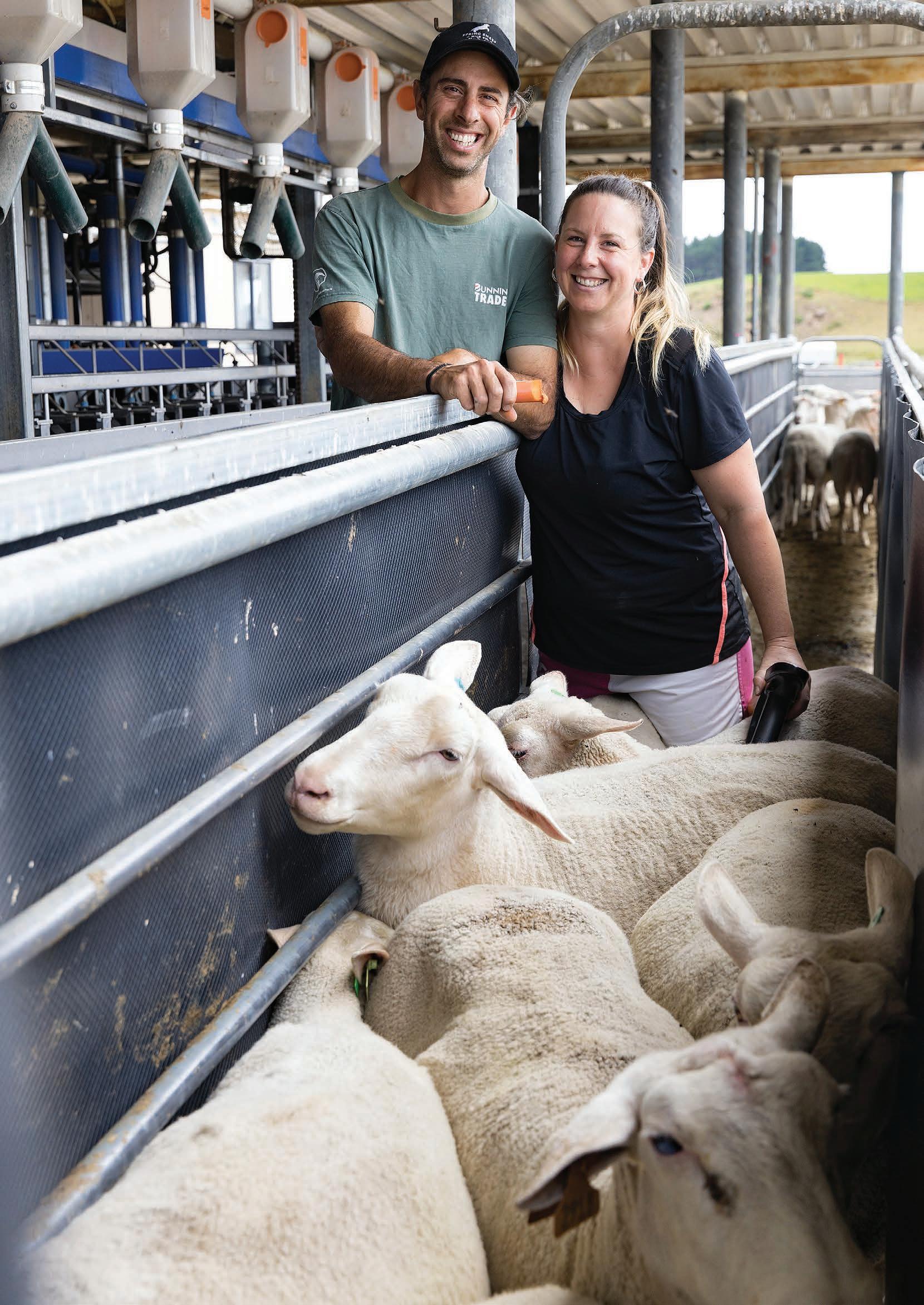
17 minute read
Doing the unimaginable
by AgriHQ
City slickers trade tyres for gumboots
Neither Matthew or Katherine Spatoro had ever worked on a farm before but that didn’t stop them from leaving the big city to go sheep milking. Stephen Barker
Despite never having farmed, a Waikato couple who had successful careers in Australia, returned home to milk sheep on the family farm and have had to learn everything from scratch.
Imagine quitting your career to embark on a new profession that is the least likely and most unexpected thing one envisions themselves doing.
That’s exactly what Matthew and
Katherine Spataro did when they ditched the city grind by shifting from Melbourne to the outskirts of Te Awamutu to milk sheep.
Both had successful careers in the tyre industry, but put these on hold to ensure Katherine’s parents’ 95-hectare farm remained in the family, with a new generation involved.
Neither Katherine nor Matthew had ever worked on a farm before.
She describes the move to her friends like this: “Imagine the least likely thing you would do in your life, and now you’re going to go and do it. That’s what we have done.”
Katherine is the sixth generation on her mother’s side to farm the property and while she grew up on the land, she and her brother had little involvement with farming.
Her parents Grant and Barbara
Rushbrooke had previously worked and run the farm, but for the last 20 years were fortunate to leave its day-to-day management with a long-time farm manager.
The Rushbrookes established and focused on a tyre importation business before buying the New Zealand network of Beaurepaires stores in 2013.
“My brother and I worked in the family business. We’ve been in tyres our whole life. Farming, not so much – the extent of our farming knowledge would have been pet day,” Katherine says.
She then moved overseas where she worked and travelled before ending up in Australia and worked for Goodyear in Melbourne. Here, she met and married Australian-born Matthew, who also worked in the tyre industry.
Then in 2018, the decision to stop milking cows was made and the family discussed the future of the farm.
Selling the farm was never going to be an option, she says.
“It’s been six generations up to my brother and I, and we wanted to see it go for another six generations,” she says.
Historically the farm had milked cows before switching to beef cattle prior to Matthew and Katherine getting involved.
The family started discussing what could be done with the farm and no idea was off the table, as long as it was environmentally and economically sustainable.
“We thought of everything – it was a clean slate,” Matthew says.
After initially dismissing sheep milking, by chance they saw a documentary on the industry.
They investigated further and the more they unearthed, the more they were convinced it was the right option because it aligned with their values.
“There was kind of that moment where something clicks and you think, I can see that life and I can see how that could work here,” she says.
“We wanted to reduce the intensity on the farm and we only use 50ha for the sheep and that allows us to be flexible with the other 45ha.”
“It’s just not as intensive. We felt like we could do more with a smaller bit of land,” he adds.
They moved from Melbourne to
Continued page 10
FARM FACTS
• Farm owners: Grant and Barbara
Rushbrooke • Managers: Matthew and Katherine
Spataro • Location: Te Awamutu • Farm size: 95ha (plus 10ha runoff used for beef farming), 50ha sheep milking and 45ha beef farming and cropping. • Production: 2-3l/day/ewe during peak lactation; sheep 650 milking ewes; 200 beef cattle (peak)
Hoof crush
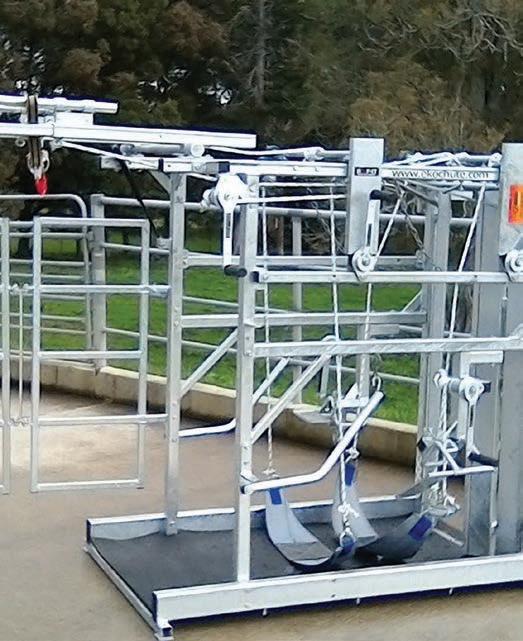
“WE TAKE THE HASSLE OUT OF HOOF CARE”
Prevent and treat lameness issues in your herd.
• Lame Cows or Bulls • Pre-mating Blocking of Bulls • Tidy-up and rebalance trims • Small and large herds • Fast, thorough and efficient • Low cost Pre-booking essential.
Balanced
Range of Hoof Care products available at www.hoofit.nz
Matthew and Katherine previously worked in the tyre industry and had to learn everything about farming from scratch. Matthew and Katherine in the milking shed during afternoon milking. Te Awamutu in May 2019 and began planning the conversion.
The family met and spoke with both Maui Milk and the Spring Sheep Milking Company and in December, signed a contract with Spring Sheep.
They began organising local contractors to retrofit the farm’s discontinued herringbone shed so it could milk sheep, as well as doubling the size of the implement shed from five to 10 bays so it could be used as a lamb rearing facility.
The covid pandemic and lockdown through late-March and into April caused delays and contractors started work on the milking shed in May.
The interior of the shed was gutted and replaced with equipment for milking sheep, turning it into a DeLaval 30-aside herringbone system. They hired two staff via video calling.
The previous farm manager had properly maintained both the pastures and infrastructure over the years, with only some minor work required on the fences to get them ready for milking sheep.
He also stayed on during the transition
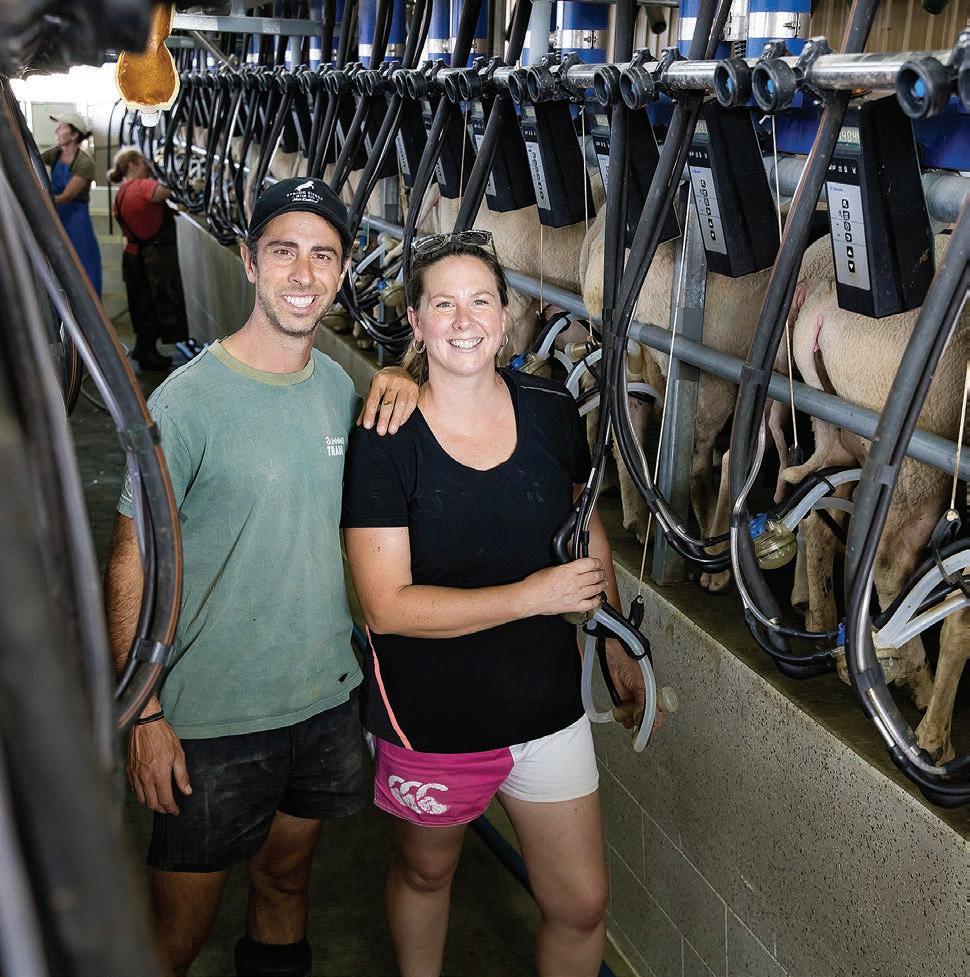


Low rate effluent irriga�on made easy. Even nutrient applica�on with automated irrigator speed control and hydraulic winch system. Even spread from 50m – 100m


ACCURATE | DURABLE | USER FRIENDLY | EFFICIENT

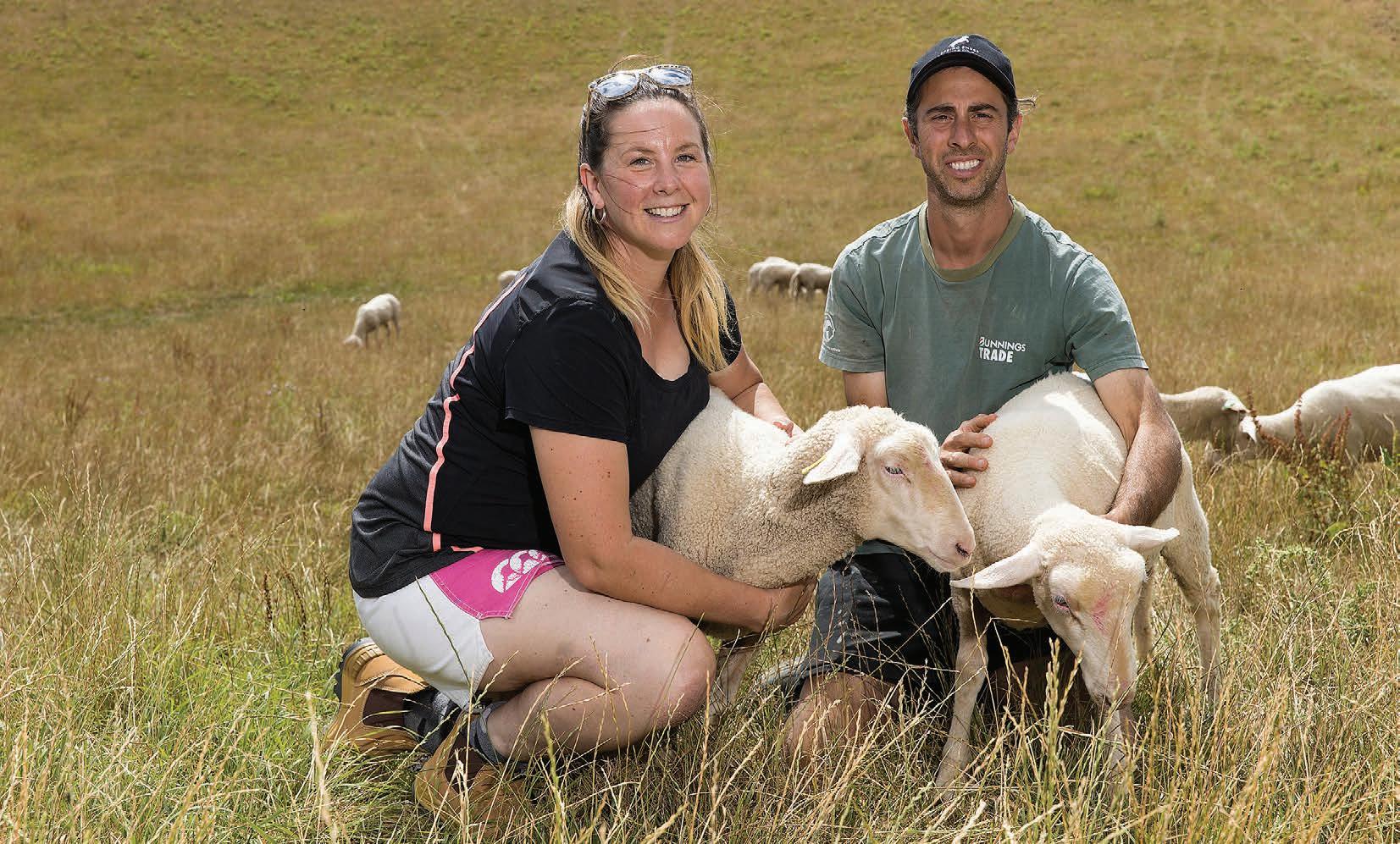
Matthew and Katherine Spataro manage Katherine’s family’s farm at Te Awamutu, where they milk 650 sheep for Spring Sheep.
period and was a useful sounding board for advice.
In June, they acquired 650 in-lamb Zealandia ewes from Spring Sheep, of which 250 were hoggets and the rest of mixed age.
The sheep came from Spring Sheep’s other farms and carried the company’s milking sheep genetics.
They modelled their budget on one of Spring Sheep’s other conversions that was of a similar size, using that farm’s budget as a template.
The company also helped them with advice around spending decisions to keep them within budget.
In total, the milking shed conversion, implement shed extension and fencing work cost them around $600,000.
The work was still being finished when the first lamb was born on July 14 – two weeks before the expected lambing date of August 1.
“Chaos began,” Matthew laughs.
“We were so close to being ready.”
They were forced to milk around 20 of these early lambing ewes, one after the other using a mobile milker until the
Continued page 12
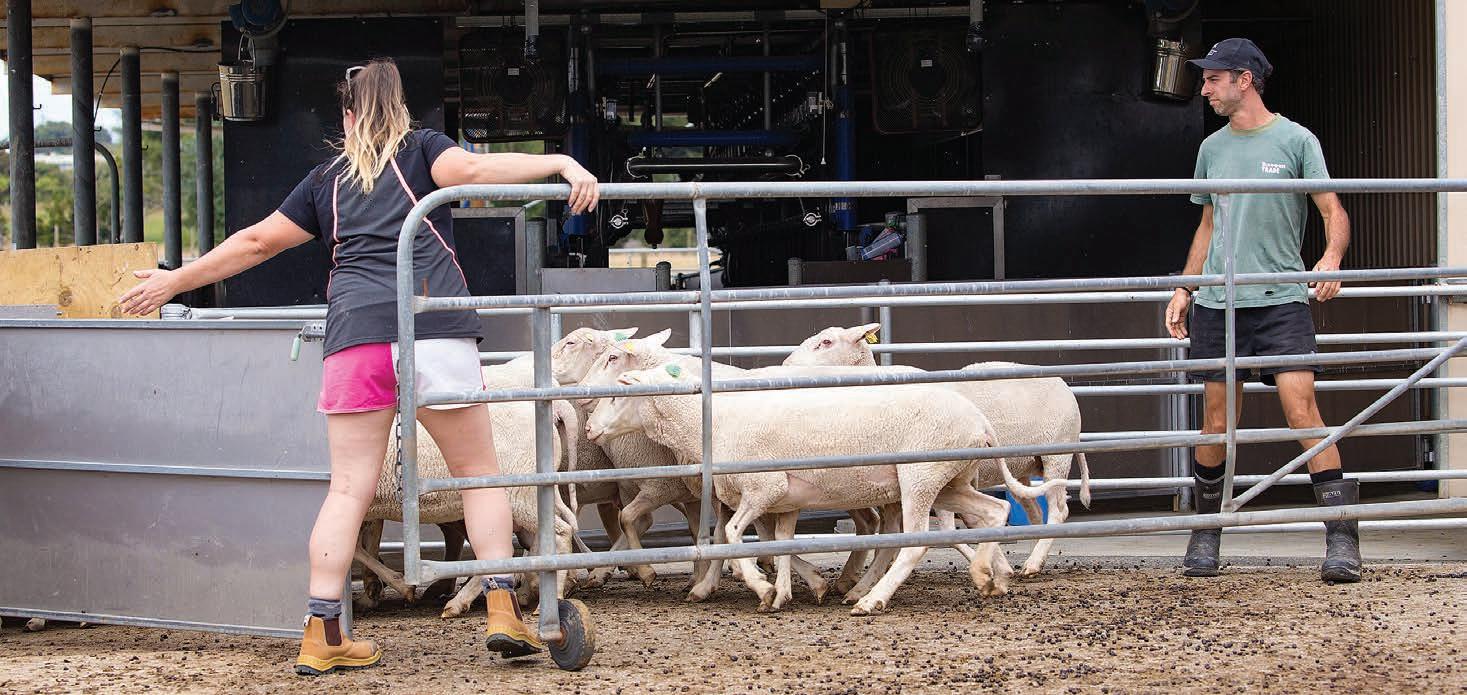

The farm used to be a dairy farm before converting to beef, and now sheep milking. The old herringbone cowshed was refitted and converted to a sheep milking shed.
work was completed, while Katherine took care of the lambs.
Compounding the situation was the early exiting of a staff member, which meant the couple had to spend more time milking and rearing than they initially had planned.
Looking back, it proved to be a blessing because it allowed them to see at the coalface what was required to run the farm.
Katherine temporarily housed the lambs in the adjacent nursery shed for two weeks while the work was completed.
“When that got to capacity, we were literally running in and out. We were having to dodge builders to get lambs into there,” she says.
“We were carrying lambs across to the bays at the back of the shed that they had finished and through their building site.”
Their last lamb was born in lateSeptember.
At its busiest, they had 50-60 lambs arriving in a day.
“That probably doesn’t sound like a lot, but when you’re in your first year and 50 little lambs turn up in a day constantly for days on end, it’s a lot of work,” she says.
The long hours involved with lambing brought home the different mindset farming has compared to her former career.
Farming meant she could not just stop what she was doing for the day and pick up tomorrow when there were newborn lambs needing to be fed.
“You can’t do that in this environment because these animals rely on you. You can’t park anything. Everything is immediate and there’s something happening right now, you have to address it,” she says.
The enormity of their career shift came as a huge shock to both of them throughout the first season as they tried to learn the skills needed to run a farm as fast as possible.
“Even though this farm’s part of my ancestry, I’ve never worked on this farm, I’ve never milked an animal before this season – and neither had Matt,” she says.
“The critical things you need to know about farming – pasture management, animal health and dairy production – we had no experience.
“We thought, ‘how hard could it be?’ And we threw ourselves at it.
“We were so naïve. But Matt and I are a bit like that, we do throw ourselves into situations and see how we go,” she laughs.
They utilised the project-based nature of their previous careers and applied that model to every aspect of the day-to-day management of the farm and planned what they were going to do and how they would do it.
They also tapped into the skillsets of the people around them and where there was something they did not know, they sought advice from Spring Sheep or elsewhere and learned the necessary skills.
It’s a very structured and organised method of management, Matthew says.
“It’s probably not what farmers do – they know what they have to do today, whereas we were the opposite – these are the tasks, everyone can see it, it’s all documented,” he says.
Advice was also constantly sought
Katherine Spataro
A small amount of grain is used in the milking shed to entice the ewes onto the platform.
Matthew and Katherine with Natalie Bell, head miker and 2IC David Shaw drench the sheep.

from Spring Sheep on what tasks needed to be completed as the season commenced, so they were front-footing everything as much as possible.
They are also as transparent as possible with their staff, so everyone knows exactly what was planned for the day.
“We have taken our skills from our past lives and have applied them as much as possible to this environment and tapped into the critical things we don’t know and needed to know,” she says.
Their ethos with their staff is “little and often,” because they see and interact with their ewes on a much closer basis than a large-scale, conventional sheep farmer.
In the months prior to lambing, they sought advice from both sheep farmers and cow dairy farmers.
They found that much of the advice from the dairy farmers to be more useful to sheep milking than from the sheep farmers.
“Their sheep are not like our sheep. A lot of the things we were told from the sheep and beef guys are not relevant. We lean more on the dairy side of things,” he says.
Other new farms to the industry also underestimated the labour involved with lambing. Most had come from bovine dairy backgrounds and had assumed it was the same.
“It’s not,” he says.
“Everyone who has done this – and we have all spoken on the phone – we all rang each other up and to say, ‘Woah, this is a lot harder and we need more people than we thought’.”
The lambs spend the first 48 hours with their mother so they are fed colostrum before being transferred to the nursery pen.


Feet maintenance is a constant for sheep particular with the amount of walking they do back and forwards to the shed. Katherine trims a sheep’s hoof. Every Friday, the team selects, assesses and trim hooves. David Shaw, 2IC and Natalie Bell, head milker, trim hooves.
In the pen the lambs are then taught how to use the automatic feeders, a process which takes 24-48 hours.
The lambs are then fed at least four times a day using automatic feeders. It is an incredibly labour-intensive process, Katherine says.
She would also check in on the lambs at 9.30pm before going to bed before being up at 5.30am for their first feeding.
At a 165% lambing rate, the older ewes were birthing mostly twins and triplets and two had quadruplets, while the hoggets had mostly singles.
In total, over 900 lambs were reared in the shed. They reared about 450 ewe lambs, with the remaining ram lambs either sold to a finishing farm or retained as wethers.
Once they are feeding unaided, the lambs spend a further week in that shed. Once they reach about 5-8kg, they are health-checked, tagged and graduated to a larger pen, where they are run in larger groups for six weeks.
Over that time, they have access to a combination of milk and a grain mix, as well as having access to grass.
The lambs are slowly weaned off milk over 6-8 weeks, and eventually let out into a paddock.
They are also weighed monthly to record weight gain and are run as three mobs, the heavies, the mediums and the lighter sheep.
Matthew says they are looking forward to having more control over the process next season when they start mating their ewes near the end of February. This should condense their lambing this winter, starting mid-July.
Their earlier born lambs are looking fantastic with a mob of 150 on target to meet their 45kg weight goal when they put the rams out.
“Just when we feel like we’ve finished rearing lambs, it all starts again,” she says.
Another change for the new season will be taking on a farm manager.
This will also allow them to take a small step back from day-to-day farm operations and focus on the business growth and farm development.
While Katherine oversaw the lamb rearing, Matthew milked the ewes, managed the pasture and kept an eye on the flock’s health.
They run the ewes outdoors, using a traditional rotational grazing system on the pasture similar to bovine dairy, in two mobs split by age.
A small amount of grain is used in the milking shed to entice the ewes onto the platform and they have 10ha of chicory planted as a summer feed crop.
That crop will be expanded in their second season because it had performed so well in holding up milk production as it became drier.
They were also blessed with a kind growing season in contrast to the drought that hit Waikato in early 2020.
During peak lactation the sheep were producing around 2-3 litres a day. That has since eased back to around 1l/day per sheep.
Production fell in November, which initially made them panic that their inexperience had finally caught them out.
After taking advice from a feed expert, they tweaked the ewes’ supplementary feed and it turned around quickly.
“That was again falling back on those specialists that we knew,” she says.
“Spring Sheep also assured them that it was a season trend and not farmspecific, and the information shared between farms assisted us during this time.”
The rest of the season has gone pretty well, she says.
After the income from their beef cattle is factored in, they believe they have broadly stuck to their budget.
Once they undertake their full farm seasonal review, they say they will know in more detail their production costs per litre of milk.
The sheep are also more used to human interaction than their meat-bred counterparts. This makes them gentle and calm enough that Matthew does not need dogs.
“In the morning, I’ll open a gate and they’ll come running up. I say ‘come
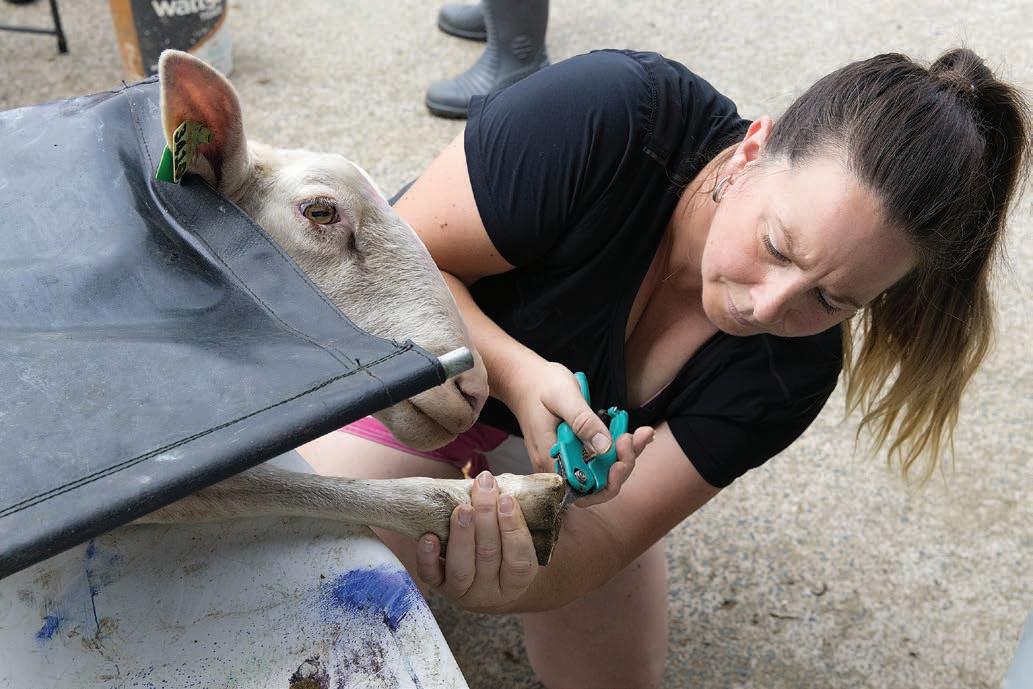


Matthew and Katherine load up the side-by-side before heading out to do jobs on the farm.
on, girls,’ and they’ll come,” he says.
“They’re like 650 lambs that you’ve raised and now they want to hang out with you. They’re like pets.”
This makes handling them easier and saves time when it comes to animal health jobs such as weighing, drenching and vaccinations.
They shear the ewes twice a year, in January and June, and more recently treated the entire herd with boluses for facial eczema protection.
Feet maintenance is constant for sheep particularly with the amount of walking they do back and forwards to the shed.
They installed a footbath on the exit from the milking shed, which the flock walk through every day and on “Feet Friday,” when the team will select a group of ewes to assess and trim their feet.
The Spataros meet regularly with the other Spring Sheep suppliers to catch up, compare production figures and swap ideas on how to fine-tune their businesses.
Matthew says they are on target to keep milking into April before deciding when to dry off. Once that happens, they will monitor the ewe’s health to ensure they are in the best possible condition for lambing.
The 45ha beef operation remains a work in progress for the Spataros. At its peak, it had 200 beef cattle, including 50 Hereford breeding cows, their calves and 40 cattle grazing a 10ha runoff block near Hamilton.
For now, they will retain some cattle as the summer feed crop and milking ewe flock slowly grows.
“It’s given us options to supplement what we are doing, but in the longerterm we still have to figure it out,” he says.
Ideally, he says he wants to retain some cattle on the farm to keep cleaning up the pastures after the ewes.
Initially they farmed the sheep and the cattle separately, but that soon changed when they realised it was not an efficient use of land and in October, began using the cattle as a tool to clean up pastures after the sheep.
“We realised it was silly. We needed to be skilled on everything that runs on this farm – and on this farm, we have sheep and beef,” he says.
Despite the challenges, they have learned to love their new lifestyle.
Matthew says farming has made him physically fitter than he has ever been, while Katherine enjoys no longer being stuck in an office all day.
“There’s something nice about being up at 5.30am when the sun is coming up and the ewes are trotting off to the shed. It’s a peaceful moment,” she says. n
Increase your farms Production, Profitability & Environmental Sustainability. DDPhos Granulated RPR.

Improved Phosphate Utilisation
Slower releasing non water-soluble phosphate in DDPhos can improve the return on your phosphate applications by reducing the amount of Phosphate that is both leached and locked up in your soil.
Reduced Requirement for Liming
DDPhos is pH neutralising, significantly reducing your requirement for liming while helping build long term soil health.
Improved Environmental Sustainability
Turn your Phosphate applications into profit and reduce the amount of Phosphate that is being lost to the environment. At Dickie Direct we custom blend and supply a complete range of Fertilisers, Trace Elements and Biological Enhancers, delivered direct to your farm North Island wide. For more information please visit our website or contact your local Dickie Direct Area Manager.











